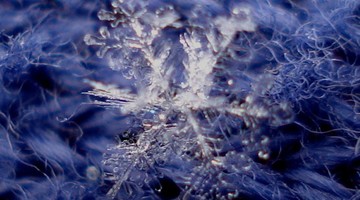This animation shows how snow on the ground is rounded and compacted, sealing off pores between the grains, trapping atmospheric gases. Snow that survives one melting season is called firn.
Falling snow crystals are usually hexagonal plates, needles, stars, or other shapes. On the ground they become unstable and sharp points are rounded and condensed into hollows. The crystals fit more closely together and over time the density of the snow increases.
At a density of about 830 to 840 km/m3, the air spaces between grains are sealed off, and the material becomes impermeable to fluids. The time it takes for pores to be closed off is critical for climate-history information from ice cores.
Snow that has survived one melting season is called firn (or névé); its density usually is greater than 500 kg/m3 in temperate regions but can be as low as 300 kg/m3 in polar regions.
Transcript
Snowflakes are compressed into round grains trapping and squeezing air.
Snow grains fuse and deform.
Air bubbles close off between snow grains - firn is formed.
The transformation of snow to firn and eventually solid ice is caused by the increasing weight of the ice.


